|
Hilbre
Bird Observatory - Half A Century of Bird Ringing and Recording
by Bob Anderson and Steve Williams
The tidal Hilbre islands consist of some six hectares of land and rock in
the Dee estuary, about 1km from the nearest point of the mainland at Red
Rocks. Their location in the rich feeding grounds of the estuary make them
important as a roost site for waders. Hilbre itself is the largest of the
group, at something less than five hectares; most of its surface consists
of rough grassland and some bare rock, but a cluster of buildings of
various ages occupies the lower, east side of the island. Their associated
(private) gardens and paddocks provide shelter for passerine migrants. The
main island’s position at the extreme north-west point of Wirral means
that, along with the peninsula’s north shore, it affords opportunities for
seawatching not otherwise found in Cheshire.
The islands have long attracted attention from naturalists, with records
of society visits going back to the nineteenth century. In the first half
of the twentieth century a succession of well-known Wirral and Cheshire
writers (e.g. Coward, Boyd and Ellison) visited Hilbre, while the
opportunities for wader photography were exploited first by Farrar and
later by Hosking and others. Drawing upon these sources, and the
increasing number of records available from local societies and
individuals, Ellison and Craggs (1) produced a checklist of the birds of
the islands in 1955. Hilbre was therefore already a well-known and
well-recorded site even before the inception of the Bird Observatory.
Nevertheless, a group of local birders who were already visiting the
islands regularly felt that more could be learned by systematic
observation and ringing, and the Observatory came into being early in
1957. The annual report produced that year was the first of an unbroken
sequence extending to the present day (2). It should be said that, from
the start, the interest was not wholly in birds but in all aspects of the
islands’ natural history: for example, there is a fifty-year sequence of
counts of the Grey Seal population, while light trapping of moths is a
more recent development. This is reflected in the comprehensive volume on
Hilbre edited by Craggs in 1982 (3) and in the annual reports, but such
activities are beyond the scope of the present paper.
The Observatory
The main movers in the creation of the Hilbre Bird Observatory (HiBO) were
John Gittins, a dynamic West Kirby man with a long association with the
island, and Professor J D Craggs, who was already ringing House Sparrows
Passer domesticus on Hilbre as part of his long-term study of the small
colony then resident there. Fuller appreciations of the work and character
of these two memorable and much-loved personalities can be found in
obituary notices in CAWOS Bird News (4) and HiBO reports (2-1999 and
2-2001). They were joined by seven other founder members, four of whom
were products of the then flourishing Birkenhead School Natural History
Society, and over the next few years a succession of Wirral-based birders
and ringers was added to the membership.
Birding in 1957 was very different from today, and more localised. The
leisure market had yet to take off; equipment was more basic; information
was much more limited; travel was far more restricted, and expensive.
Ringing probably represented a more exciting option for young birders than
it does in 2007. The beginnings of the Hilbre Bird Observatory have to be
seen in this context. The primary motivation of the founder members was to
learn more about the birds passing through the island and the waders
feeding around its shores, but there was also the attraction of
contributing to wider knowledge. The network of major observatories was,
by now, established; a case was recognised (notably by Kenneth Williamson
at the British Trust for Ornithology, who offered early encouragement to
Hilbre) for smaller “mini-observatories” to supplement information by
filling the geographical gaps in the network.
The two key developments which enabled the Observatory to take off in 1957
were permission to construct a small Heligoland trap in one of the
gardens, and the use of a tiny hut in the grounds of one of the holiday
bungalows for overnight accommodation and as a base for ringing
activities. The original Heligoland site is still in use, though the trap
has been rebuilt several times, and subsequently two further Heligolands
were constructed in the east-side paddocks. In 1962 Hoylake UDC,
recognising the value of the group’s work, provided a rather larger hut
just north of the Canoe Club; though the building has now gone, its
enclosed garden still provides a mist-netting site. In 1989 HiBO was
fortunate to obtain, thanks to the previous occupants, the Dixon family,
the tenancy of the southernmost bungalow on the island which continues to
provide reasonably comfortable accommodation – far removed from the
original 6’x4’ garden shed.
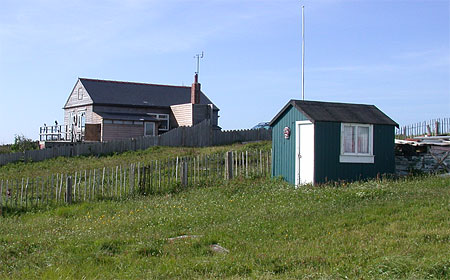
Hilbre Bird Observatory buildings: 1957-1962 (right) and 1989 to present
day (left) (Steve Williams)
Possession of a permanent base led to improved coverage. HiBO members will
normally be present on most weekends, with added effort (early morning
visits and full-time residence on the island) at peak migration periods.
Typically, the island will now be visited for ringing or recording
purposes by members on 250 or more days in the year.
Ringing Activity
Despite the time and expense involved in their maintenance, the Heligoland
traps remain a mainstay of ringing at Hilbre. They are sited in the
limited cover available on the island, and are effective on an exposed
site even when weather conditions limit mist net use. They are
supplemented, for passerine trapping, by mist nets and some small wire
(Potter) traps. Early wader ringing involved S-traps, clap-nets and
dazzle-netting (the last a somewhat hazardous activity, utilising Aldis
lamps and wet-cell batteries on slippery rocks) before the advent of
rocket nets to catch roosting waders. The latter led to a brief period of
relatively large wader catches, but the practice was discontinued in the
1970s. Before the organisation of the Dee Estuary Voluntary Wardens the
roosting flocks at the mouth of the estuary were subject to serious
disturbance by various public activities; the Dee became known as an
“aerial roost” (the birds spending the tide in the air), and HiBO
concluded that cannon netting on the islands would not help this
situation. Limited wader ringing continues, primarily using mist nets but
only at night.
It was always accepted that (waders briefly apart) Hilbre would never
produce large ringing totals: a presentation on the HiBO’s work at the
North-West Ringers’ Conference in March 2007 took as its theme the
statement that “size isn’t everything” - that even a small site could
contribute something to ornithological knowledge.
However, since 1957, HiBO has ringed over 32,000 birds (excluding early
rocket netting of Oystercatchers Haematopus ostralegus which involved
several thousand birds) of almost 100 species, but this modest total
includes some useful results.
Of these 32,000 birds the pie chart below indicates that a very high
proportion, almost 88%, is of passerines.
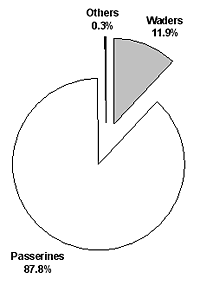 Figure 1
(left): Pie chart showing percentage of passerines, waders and other
species ringed by HiBO 1957-2006. Figure 1
(left): Pie chart showing percentage of passerines, waders and other
species ringed by HiBO 1957-2006.
Willow Warbler Phylloscopus trochilus is clearly the dominant passerine
species with over 10,000 now ringed at Hilbre (representing about 1% of
those ringed by the BTO), and is interesting on a number of counts.
The numbers illustrate how ringing expanded knowledge of the birds of an
already well-watched site: in 1957 it was known that a few could be seen
frequenting the gardens, but nobody then guessed that fifty, sixty or a
hundred individuals could be present, and ringed, in a single day.
Moreover, bearing in mind its size and overall totals, Hilbre punches
above its weight when compared with the national average for recoveries of
many of the species ringed at Hilbre and this includes the Willow Warbler.
Not surprisingly, HiBO members have taken a particular interest in
patterns of Willow Warbler movements.
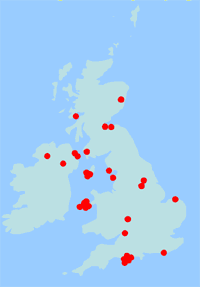
Figure 2 (right): Map indicating some of the British recoveries and controls of
Willow Warblers obtained by HiBO.
The pattern of recoveries and controls from HiBO is interesting; we have
had a number of recoveries/controls from Scotland and Northern Ireland.
This has led us to believe that the majority of Willow Warblers passing
through Hilbre (particularly in August) are from these breeding areas and,
to a lesser extent, northern England. This is emphasised by birds ringed
in these areas during the breeding season and then captured on Hilbre
during the August return migration or in some instances the following
spring.
There is also evidence to suggest that birds use the same west coast
migration routes with several recoveries/controls each from Portland,
Bardsey and Calf of Man Bird Observatories, including birds ringed and
captured in subsequent springs. However, interestingly, we have only had
one from the east coast (ringed at Holme Bird Observatory in Norfolk on 12
May 1969 and controlled at Hilbre on 8 May 1970). We have several examples
of Willow Warblers that have presumably overshot their intended
destinations as they have been ringed on Hilbre (for example, one bird on
20 April 1988) and subsequently controlled further south (e.g. the same
bird retrapped on Bardsey three days later on 23 April 1988).
There are also several foreign recoveries and/or controls of Willow
Warblers and these have helped add to the ‘bigger picture’ that the BTO is
compiling. A couple of examples are a bird ringed in Switzerland on 9
April 1980 and caught on Hilbre six days later, another ringed in Belgium
on 23 April 1987 and captured at Hilbre on its return south on 17 August
1989 and one ringed at Hilbre on 12 September 2002 and captured in
southern Spain on 6 October 2002. This latter bird was captured at a
traditional feed-up area and was probably its last stop before it made its
trans-Saharan crossing.
Weather patterns have also been closely studied at Hilbre by HiBO and here
are two weather charts which indicate the classic fall conditions required
for the arrival of large numbers of Willow Warblers (and other species are
involved in much smaller numbers) at Hilbre in spring (figure 3) and
autumn (figure 4).
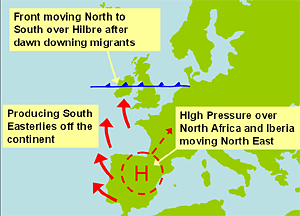 Figure 3
(left): Classic spring weather conditions for a large fall of passerines
on Hilbre. Figure 3
(left): Classic spring weather conditions for a large fall of passerines
on Hilbre.
The chart for spring (figure 3 left) shows high pressure centred over
North Africa and the Iberian peninsula moving north-eastwards. This
produces south-easterly winds off the Continent. A front moving north to
south arrives at Hilbre after dawn producing cloud cover and/or rain which
downs lots of nocturnal migrants (typically involving Willow Warblers).
The autumn chart (figure 4 below) is taken from the largest fall of Willow
Warblers to ever occur on Hilbre (5 August 2006) when high pressure north
of and over Scotland produces ideal conditions for birds to leave their
breeding grounds (clear skies and light winds) and a north-easterly airstream. A front moving west to east
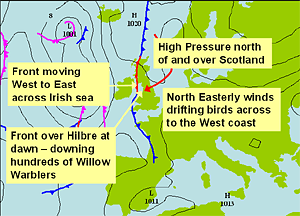 across the Irish Sea arrives at
Hilbre at dawn ‘grounding’ literally hundreds of Willow Warblers. For more
detailed analysis of the autumn chart readers are referred to CAWOS Bird
News (5). across the Irish Sea arrives at
Hilbre at dawn ‘grounding’ literally hundreds of Willow Warblers. For more
detailed analysis of the autumn chart readers are referred to CAWOS Bird
News (5).
Figure 4
(left): Classic autumn weather conditions for a large fall of passerines
on Hilbre.
Other birds, though ringed in smaller numbers, have added to local
knowledge and/or produced interesting recoveries. Grasshopper Warbler
Locustella naevia is a good example. A species not recorded at Hilbre
prior to the establishment of the Bird Observatory in 1957, a remarkable
225 birds have been ringed at Hilbre in the 50 years since. This
represents just over 1% of Grasshopper Warblers ringed in the UK during
that time and the recovery in Scotland of a Hilbre-ringed bird was an
early reward for our work in 1963.
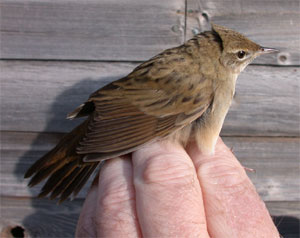 Grasshopper Warbler
Locustella naevia
(right), 225 have been ringed on Hilbre
1957-2006 (Steve Williams). Grasshopper Warbler
Locustella naevia
(right), 225 have been ringed on Hilbre
1957-2006 (Steve Williams).
So far as waders go, attention has always been concentrated on Purple
Sandpipers Calidris maritima - a speciality of the island, though sadly
reduced in numbers in recent years (e.g. a maximum of only 29 birds during
2006, against a peak of over 70 in the 1960s). Colour ringing demonstrated
the return of individuals year after year, and in 1964 a bird ringed at
Hilbre five years earlier was shot (allegedly by an Eskimo hunter) in
Greenland. This was something that encouraged HiBO members for many years,
being the first overseas recovery of a British-ringed Purple Sandpiper and
early evidence of the origins of our wintering west coast birds.
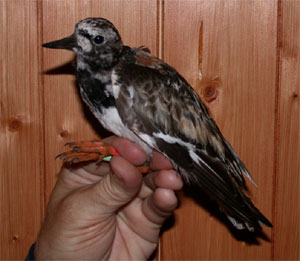 Turnstone
Arenaria interpres
(left), one of many colour ringed on Hilbre over the
last decade
(Steve Williams). Turnstone
Arenaria interpres
(left), one of many colour ringed on Hilbre over the
last decade
(Steve Williams).
Similarly, with our colour ringing of Turnstones Arenaria interpres we
have had a number of birds seen or captured on passage in Iceland as well
as numerous sightings of our birds around the west coast of Britain.
Clearly, there is not enough space to celebrate the ringing achievements
of HiBO despite its size. These are just a few illustrations that suggest
that the Observatory has succeeded, as a ringing station, in terms of its
original ambitions. Additionally, the founders’ hopes for the occasional
rarity have been met over the years, and several species have been added
to the county list. These are discussed further in the next section.
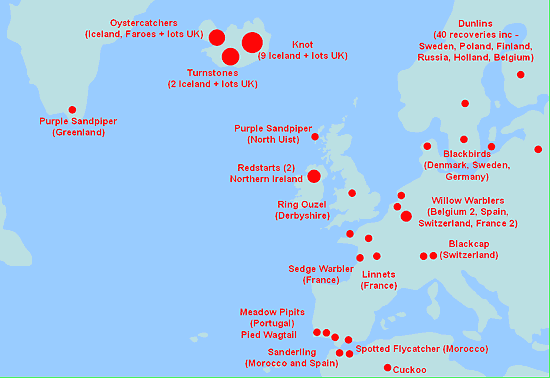
Figure 5: Sample of interesting recoveries/controls from HiBO ringing
efforts 1957-2006
Records and Observations
A crude but significant measure of the Observatory’s contribution to
knowledge of Cheshire’s birds is that in 1957 the total number of species
recorded on Hilbre stood at 157; by the end of 2006 it had risen to 260
(this on an island which had been well watched, and in the opinion of one
noted county ornithologist, speaking not long after HiBO was established,
was “over-watched”). The current figure includes an impressive list of
rarities and/or birds new to the county, some of which might not have been
discovered had it not been for the ringing effort.
Some of the more interesting examples include the first Cheshire and
Wirral Yellow-browed Warbler Phylloscopus inornatus on 13 October
1973 – Hilbre has since had seven more records of this delightful, once
much sought after, rarity. 2007's fine male Subalpine Warbler Sylvia cantillans was the second for Hilbre but
only the fourth for Cheshire and Wirral. Two each of Melodious Hippolais
polyglotta and Icterine Warblers Hippolais icterina, the latter species
occurring twice on Hilbre in spring (1970 and 1973), were rare events on
the west coast and constituted the first and second records for Cheshire
and Wirral. Other good passerines have included two Woodchat Shrikes
Lanius senator (of five county records), Pallas’s Warbler Phylloscopus
proregulus, Dartford Warbler Sylvia undata, and Red-rumped Swallow
Hirundo
daurica (all third county records).
One of the most incredible records for Hilbre was probably the
Yellow-breasted Bunting Emberiza aureola on 7 September 1994. Very much a
Shetland speciality, this was one of the first west coast mainland
records. Obviously, seabirds are also emphasised with the first county
records of Great Shearwater Puffinus gravis (October 1971) and Cory’s
Shearwater Calonectris diomedea (August 1980). Other notable species
include Laughing Gull Larus atricilla, two White-winged Black Terns
Chlidonias leucopterus and Collared Pratincole Glareola pratincola
(another first record for the county).
The rarities apart, regular observation has led to improved knowledge of
frequency of occurrence, and/or fluctuation in numbers of all species that
occur on or around the Hilbre islands group.
Many examples of species’ status that have changed considerably in the
time that HiBO has been running are from a positive perspective – Storm
Petrel Hyrdobates pelagicus, Brent Goose Branta hrota/bernicla,
Sparrowhawk Accipiter nisus, Osprey Pandion haliaetus, Marsh Harrier
Circus aeruginosus, Little Egret Egretta garzetta, Long-tailed Skua
Stercorarius longicaudus and Little Gull Larus minutus. Some of these are
simply as a result of the species increasing within and/or expanding their
range but other reasons, such as better identification awareness (e.g.
Long-tailed Skua) and observer awareness of when and where to look (e.g.
Storm Petrel and Little Gull) may also have played a part.
Figure 6 below indicates the dramatic rise in numbers of Pale-bellied
Brent Geese Branta hrota at Hilbre in the last decade or so. Prior to the
early 1990s Pale-bellied Brent Goose was very scarce at Hilbre but before
this Dark-bellied Brent Goose Branta bernicla was the more regular of
these two closely related species.
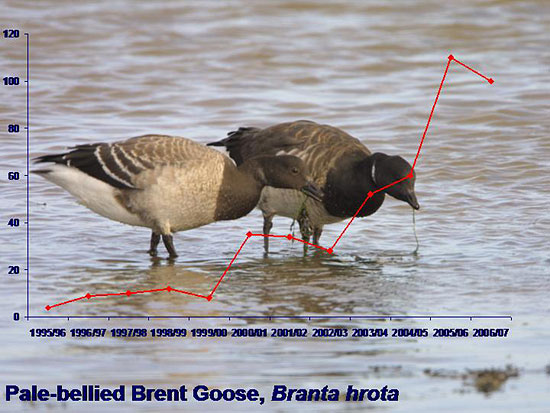
Figure 6: Peak counts of Pale-bellied Brent Geese at Hilbre from winter
1995/96 to 2006/07.
Similarly, figure 7 below indicates the dramatic increase in Sparrowhawk
records at Hilbre in the last 50 years (shown in five-year periods). It
has had a particularly significant increase since the early 1980s,
mirroring its general recovery on the mainland.
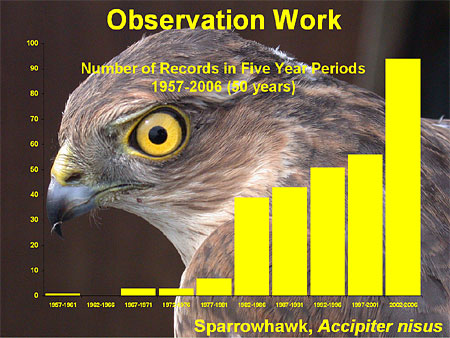
Figure 7: Number of Sparrowhawk records at Hilbre in five-year periods
1957-2006 (50 years)
Those species that have been affected with a downward turn in recent times
sadly include two of our favourite species, namely Willow Warbler and
Purple Sandpiper. The former has seen a decline nationally and the latter
has seen numbers dwindle in the last few winters. The reasons for the
Purple Sandpiper decline are possibly partly due to more movement between
wintering sites in north Wirral (with better feeding habitat available at
Wallasey and Leasowe), but more likely that birds are staying further
north in winter, although this latter suggestion is yet to be proved.
Seawatching has always attracted birders to Hilbre, and no seabird more
than Leach’s Petrel Oceanodroma leucorhoa – adopted as the symbol for
CAWOS as well as HiBO. Long associated with autumn north-westerly gales
there is perhaps no better place on the ‘mainland’ of Britain to watch
this enigmatic petrel, in terms of location, ambience and views of the
birds themselves (but of course we are biased!). However, all of the other
important seabird sightings and counting that HiBO carries out should not
be passed over. Hilbre, and HiBO in particular, is particularly
significant in county terms for providing data for divers, grebes,
shearwaters, sea-ducks, gulls, terns and auks (as well as waders and
passerines as already discussed above).
The limited land area of the islands makes it relatively easy to study,
and ring, the limited population of resident birds. The House Sparrow
colony which attracted Craggs, and was the subject of two papers by him
(6), (7) was largely dependent on livestock foodstuff, and disappeared
many years ago. However, a number of passerine species breed on the
islands, and are studied through five-year cycles using territory mapping
methods. Of particular interest are the flourishing Linnet Carduelis
cannabina colony (the subject of an ongoing study) and Wren Troglodytes
troglodytes (the island having once been regarded as unsuitable breeding
habitat). Additionally, about 15 pairs of Shelduck Tadorna tadorna now
breed – a significant increase from the two or three pairs to be found
when the Observatory began, and consistent with changes elsewhere in the
county.
The observation work carried out by HiBO is not restricted to the daily
log of species and numbers and the ringing efforts, but also includes
provision of data to CAWOS and other organisations, the Winter Gull
Survey, Wetland Bird Survey, Breeding Bird Survey, Brent Goose Survey,
CAWOS Wintering and Breeding Atlas surveys and the BTO Atlas survey work
planned to commence in the winter of 2007.
Conclusion
Has it worked out as the founder members hoped, and has it been
worthwhile? This brief account of fifty years’ work on the islands
suggests that the answer to both questions should be in the affirmative.
The twin aims of finding out more about the birds using the islands and
making a contribution, however modest, to wider ornithological knowledge,
have been achieved. As changes take place over the years, there are always
new questions to answer, and new trends to be identified. There seems no
need to stop work, and no reason to lose interest, even after half a
century. Fortunately, the Observatory is better housed, better equipped
and perhaps most significantly, better manned and covered than it has ever
been – we are looking forward, with eager anticipation, to what the next
fifty years might produce.
Bob Anderson and Steve Williams
References:
(1) Craggs J D & Ellison N F (1955), The Birds of Hilbre Islands,
Cheshire, Northwest Naturalist
(2) Hilbre Bird Observatory (1957-2006), Hilbre Bird Observatory Report,
HiBO
(3) Craggs J D, Ed (1982), Hilbre – The Cheshire Island, Liverpool
University Press
(4) Anderson R (2002) Bird News No 53, CAWOS
(5) Williams S (2004), Bird News No 64, CAWOS
(6) Craggs J D (1967) Bird Study volume 14, pp53-60
(7) Craggs J D (1976) Ibid volume 23, pp 281-284
Acknowledgements:
Many thanks are due to Chris Williams for providing data on ringing,
recoveries and controls and also to Pete Williams for commenting on an
early draft and reviewing the final draft of this article.
Editor: this article first
appeared in the Cheshire and Wirral Bird Report 2007 and appears here with
the kind permission of the Editors and Authors.
Top of
page
January
Bird News
|
|

Cattle Egret at Neston, Jan 8th 2008,
Steve Round ©
The Christmas
period saw an influx of Cattle Egrets into the country, at least 30, and
one of these duly turned up here. Although news only reached birders on
the 3rd apparently it had been present on farmland next to the A540 near
Neston at least a week before that. This
is the second record for Wirral. It, or possibly a second bird, was seen
on Burton Marsh on 25th and 26th. The
following day a Great White Egret was observed flying inland at the same
site at dusk, and was relocated off Neston
Reed Bed on the 30th.
A look at the
Brent Geese graph in the above article (figure 6)
demonstrates the dramatic rise in numbers of these birds on the Dee
Estuary since the winter of 99/00. Well, they are still increasing in
number with a remarkable 172 counted on a flat calm sea off
Little Eye on 12th. These are mostly of
the pale-bellied race, the main population winter in Ireland and
apparently a record number of 29,500 were present at Strangford Lough
(near Belfast) in October 2007 with 30% young, so this population is
obviously doing very well. Pink-footed Geese are another species doing
well. We sometimes get large movements over the estuary with birds moving
from Norfolk to Lancashire, max count this month was 500 on 14th over
West Kirby. But we also have an
over-wintering flock on the marshes, this flock seems to be increasing
slowly each year and max count was 320 on the 25th giving good views from
Parkgate and Neston, they seem to be very
active at high tide flying off the edge of the marsh. Whooper Swan is
another bird which is increasing, the 61 counted on
Shotwick Fields on the 1st is almost
certainly a record high count for that site. Other wildfowl of note was a
first winter male Long-tailed Duck seen off
Hilbre on several days at the start of the month, up to 450 Pintail
spent most low tides in the channel off
Thurstaston and at least 300 Common Scoters were off
Point of Ayr on 26th, no doubt just a very
small portion of the total Liverpool Bay flock.
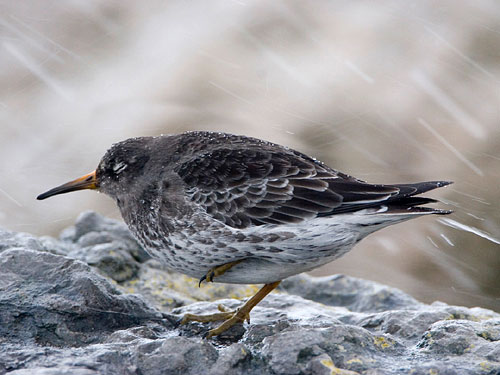
Purple Sandpiper bravely coping with sea spray
on rocks below the Lifeguard Station,
Wallasey Shore, Jan 25th 2008, Matt Thomas ©
A mainly mild and windy month meant low numbers of waders, although 2,100
Black-tailed Godwits and six Spotted Redshanks at the
Connah's Quay Reserve are not bad
numbers. We've also had reasonable numbers of Purple Sandpipers with at
least 40 on Hilbre, 11 on rocks by the
Wallasey Lifeguard Station and seven on
a platform on New Brighton Marine Lake
at high tide. There seems to have been loads of Oystercatchers around
although I haven't seen any total counts for the estuary, but we've had
good numbers roosting on West Kirby Shore
nearly every high tide ever since they returned from breeding in late
summer, 6,000 was max this month. We've still got some overwintering
Greenshank with singles seen at Heswall,
Gilroy Nature Park and West Kirby Marine
Lake, with two at Connah's Quay.
The same windy
weather which suppressed wader counts brought in a pale phase Arctic Skua
off West Kirby on 24th, I think this
is the first ever Jan record for Wirral although we have had several
December records in the past. There have been both Marsh Harriers and Hen
Harriers of Burton,
Heswall and
Parkgate, usually only single birds have been noted but there were two
Marsh Harriers off Burton on 2nd and
Parkgate the following day, and two Hen
Harriers off Neston Reedbed on 19th. At
least three Peregrines and two Merlins were regularly observed through the
month. Up to four Short-eared Owls have been on the marshes and there have
been some good views of Barn Owls at dusk at
Burton.
Two Snow Buntings
took up residence on Little Eye towards
the end of the month, with singles briefly at
West Kirby and
Hilbre. 15 Brambling were at
Connah's Quay on 21st and 25 Twite was
the max seen at Flint Castle. Cormorant
numbers continue to increase, one day at
West Kirby we counted a total of well over 1,000 on
Bird Rock,
Little Eye and flying south down the estuary.
What to expect in February
Brent Geese numbers will still be high at the beginning
of the month, in some winters they peak in February although it would be
remarkable if we increased on January's figures! February is also the
month when Common Scoters peak in Liverpool Bay, most will be
further west but we can still get good numbers with 3,000 counted off
Point of
Ayr last year. Look out also for the much rarer Velvet Scoter. Other
wildfowl should include Gadwall at the Connah's Quay
Reserve, 22 were here
last Feb. Also at Connah's Quay should be several Spotted Redshanks, they
particularly like the Bunded Pool.
Apart from Oystercatchers numbers of waders have been
well down this winter, but a cold still spell over several days should see
Knot and Dunlin numbers rocket. A still day would also be ideal conditions
to see Great Crested Grebes off North Wirral, a record 458 were counted
last Feb.
Unfortunately no big high tides are due this month, the
max height being just 9.7m, we would need a strong westerly gale to bring
that over the marsh at Parkgate. However, a visit to the car park at
Heswall Riverbank Road should be rewarding, the tide covers the marsh at
much lower heights here than Parkgate. We should get good views of
Short-eared Owls, and probably Water Rails and Hen and/or Marsh Harriers as
well as the usual waders and ducks.
Many thanks go
to Richard Steel, Steve Liston, Neil McLaren,
Jimmy Meadows, Matt Thomas, Andrew Wallbank, Paul Vautrinot, Roger Morgan,
Mike Cocking, Tony Twemlow, John Kirkland, Pete Hilton, John Ferguson, David Haigh,
Mike Hart, John Jakeman, Henerz Cook, Iain Douglas, Graham Thompson, Allan Conlin,
Dave Wild, Graham Jones, Steve Round, Steve Williams,
Dave Edwards, Chris Butterworth, Jane Turner, Charles Farnell, Paul Shenton,
David Small, Gilbert Bolton, Steve Ainsworth, Damian Waters, David
Thompson, Mark Gibson, Alec Thomasson, Colin Schofield, Allan Hewitt, John Tubb,
Dave Harrington, Paul Roberts, Norman Hallas, Phil Woollen,
Phil Liston, Colin Davies, Jason Stannage, Bernard Machin,
Michael Clarkson, Mike Jones, Peter Poole, Nigel Young, James Smith, Rob
Black, Ian Bedford, Steve Hassell, Bryan Joy, Steve Roberts, Richard
Graham, Bernard East, Peter Poole, Graham Mercer, the Dee Estuary Voluntary
Wardens and
the Hilbre Bird Observatory
for their sightings during December. All sightings are gratefully
received.
Top of page |


